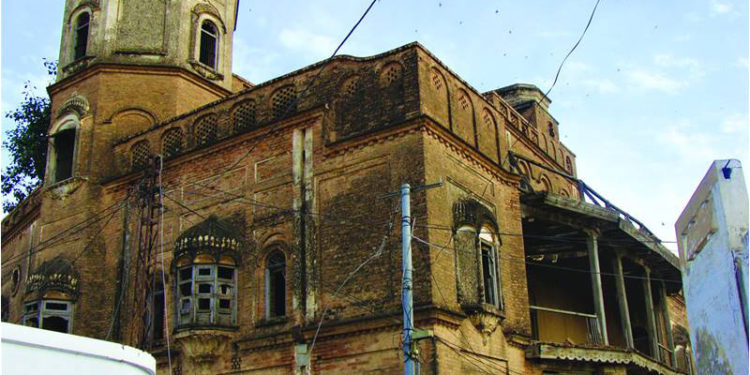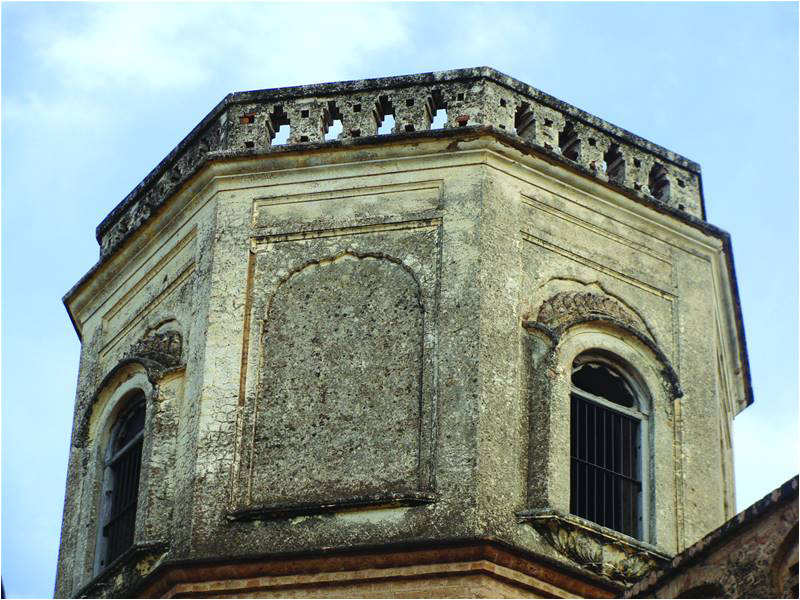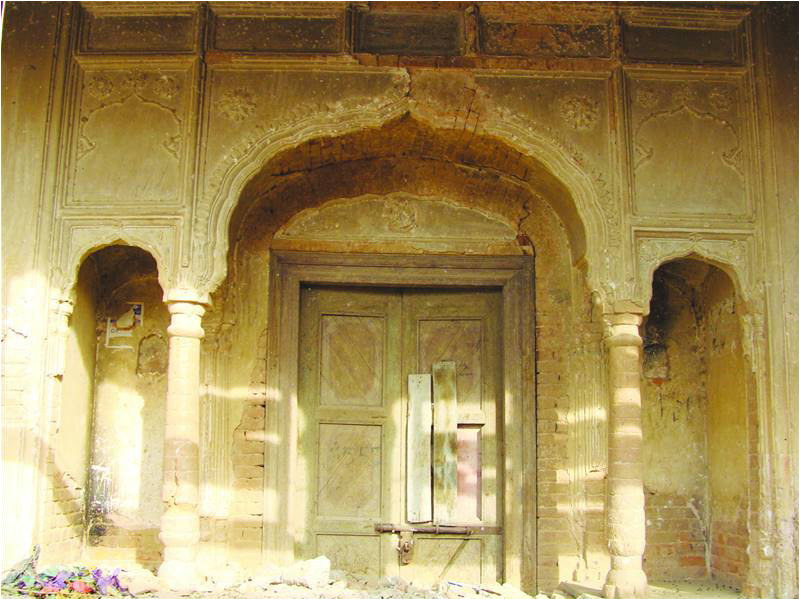
Kauntrila, a historic town of Pothohar, situated 15 km south of Gujar Khan, has a number of buildings and places of the Mughal period. However, Bakhshi Ram Singh Haveli has its own unique grace.
Zulfiqar Ali Kalhoro
The landscape of Pothohar in Punjab is host to number of havelis belonging to Muslims, Hindus and Sikhs. “Haveli” is a word of Persian origin which denotes a great mansion associated with wealth, status and size. In architectural terms the haveli was merely a very grand version of the common urban house.
The majority of the havelis in Potohar are believed to have been erected during the British period. The distinctive features of the Potohari haveli are jharokas, wooden balconies, carved wooden doors, raised platforms, the dhedi (built for purdah, mainly in the Muslim havelis) and towers. Compared to other havelis in Punjab, Pothohari havelis have octagonal towers that are rarely found in other parts of Punjab. Like other architectural elements of havelis, Pothohari Hindus and Sikhs also gave a special attention to the towers that crown the havelis. These haveli-towers are also decorated with paintings and a few has miniature jharokas.
Most of the havelis are also adorned with paintings drawn from both Hindu and Sikh belief systems. Muslim havelis are only decorated with geometric and floral designs. The opulent residents also used white marble at the porticos, bedrooms and courtyards of the havelis. Intricate carvings have also been observed on the marble in some of the havelis of Potohar.

A Pothohari haveli was not merely a residence but a symbol of prevailing mores. It is a remnant of the opulent community which once controlled the business of the region. Almost every small and big town in Potohar boasts havelis of then notables of the respective towns and villages. Among these would be Khem Singh Bedi Haveli in Kallar Syedan, Utam Singh Gujral Haveli in Daultala (demolished in 2013), Sikh and Hindu havelis in Narali, the dilapidated Haveli of Ratan Singh in Sagri town and the imposing haveli of Bakhshi Ram Singh in Kauntrila.
Kauntrila, situated 15 km south of Gujar Khan, is a historic town of Pothohar. It has a number of significant historical buildings and places like the Eidgah, funerary wall enclosure belonging to the Mughal period and a haveli and high school of the British period. However, Bakhshi Ram Singh Haveli has its own unique grace. It offers a conspicuous view to the visitor from a distance – reminding of Kauntrila’s past glory. The main portico of the Haveli is flanked by two columns with intricate stucco ornamentation that also decorate the main arched entrance.
The inscription in both English and Urdu above the door bears the name of builder which reads: “This building of Bakhshi Ram Singh was erected in 1886”. Bakhshi Ram Singh (d. 1926) was an engineer in Punjab Public Works Department, General Branch. He was a man of the influence during the British period in Pothohar. It is believed that the title “Bakhshi” was granted to Lajja Singh by Ahmad Shah Abdali.
Bakhshi Lajja Singh (d.1799) was the chief of the Bakhshis of Basali and was a general of Ahmad Shah Abdali. The ancestors of the Bakhshi family of Kauntrila and Basali also played an important role in political history during the Mughal period (1526-1857). Sultan Muqarab Khan Gakhar is believed to have attacked Kauntrila to avenge Raja Yousuf Khan Pakhral, the chieftain of the Pakhral Rajput tribe who had killed Hashim Khan Sadaal. But Raja Yousaf Khan fled from Kauntrila and later obtained a pardon from Sultan Muqarab Khan Gakhar. Hashim Khan Sadaal was a close relative of Sultan Muqarab Khan Gakhar (buried in Bagh Jogian, Islamabad).
Before entering the Haveli of Bakhshi Ram Singh, the double wooden balcony of the haveli attracts the visitor. Very few havelis in the Pothohar region have such imposing wooden balconies. The distinctive feature of the balconies is remarkable carving. The wooden ceilings of both the balconies are exquisitely carved out. Unfortunately the wooden screens or fretted panels of both balconies are now in a broken state.
Apart from balconies, the jharokas also lend beauty to the Haveli. There are five jharokas that decorate the outer walls of the haveli. Jharokas were made to protect women from common view. The women used to sit behind jharokas to have a view of the outside world. Mostly elderly women sat behind the jharokas. The jharokas also served as mark of the owner’s aesthetic. There are two prominent havelis in Gujar Khan Tehsil which are famous for impressive jharokas – these include the haveli of Utam Singh Gujral in Daultala town (demolished in 2013) and the Haveli of Bakhshi Ram Singh.

The magnificent Bakhshi Ram Singh Haveli is a three-storied building. It has 11 rooms and 2 underground chambers. As one enters into the Haveli, one notices a main courtyard or chowk. The main feature of the Pothohari haveli is such a courtyard. All the activities of the family members used to take place in this space. The courtyard always received special attention from the builder. One finds imposing decorative niches on the outer walls of the courtyard.
Rooms were allotted to married and unmarried persons. The elderly occupied the upper chambers – probably to keep an eye on the younger women and oversee the household chores.
The distinctive feature of Bakhshi Ram Singh Haveli are the towers that surmount the structure. There are two towers: one square and the other octagonal. The octagonal tower is an ornamental piece whereas the square has stairways to climb up and have a panoramic view of Kauntrila town and its surroundings.
Now grass and other wild growth covers the remains of the building. After Partition in 1947, the Haveli of Bakhshi Ram Singh was also used for some years as the Government Boys High School.
The Haveli should be restored, so as to convert it into a museum of Pothohari culture.
_________________________
 Dr. Zulfiqar Ali Kalhoro, an anthropologist, has authored 12 books: ‘Symbols in Stone: The Rock Art of Sindh’, ‘Perspectives on the art and architecture of Sindh’, ‘Memorial Stones: Tharparkar’ and ‘Archaeology, Religion and Art in Sindh’. He may be contacted at: zulfi04@hotmail.com
Dr. Zulfiqar Ali Kalhoro, an anthropologist, has authored 12 books: ‘Symbols in Stone: The Rock Art of Sindh’, ‘Perspectives on the art and architecture of Sindh’, ‘Memorial Stones: Tharparkar’ and ‘Archaeology, Religion and Art in Sindh’. He may be contacted at: zulfi04@hotmail.com
Courtesy: The Friday Times Naya Daur Lahore